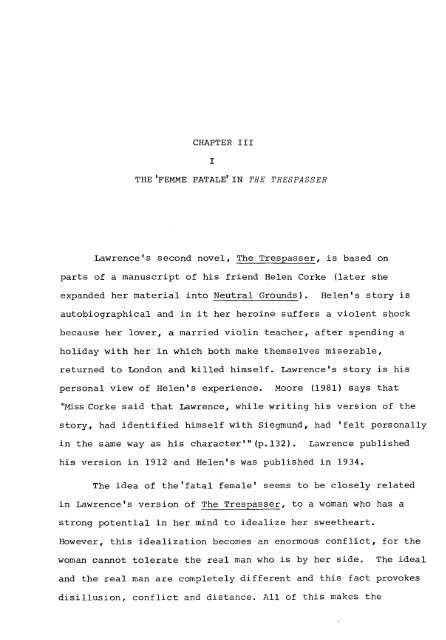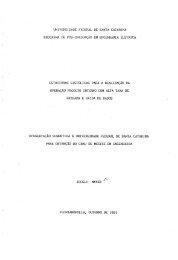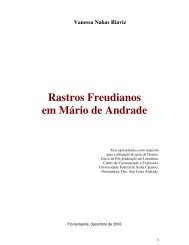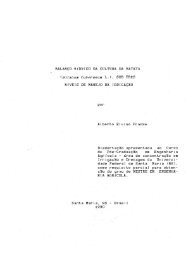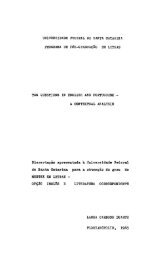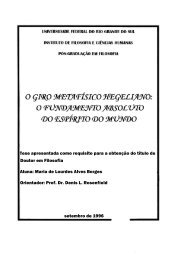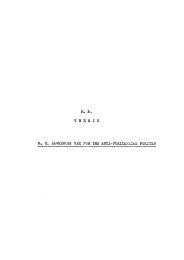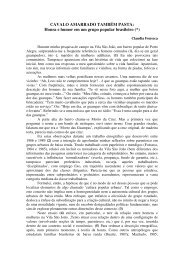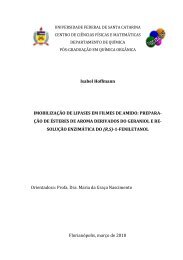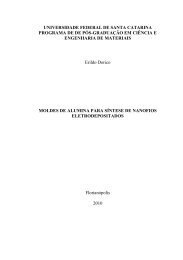- Page 1 and 2:
UNIVERSIDADE FEDERAL DE SANTA CATAR
- Page 3 and 4:
iii A todas as pessoas que ainda a-
- Page 5 and 6:
V AGRADECIMENTO ESPECIAL Ao Profess
- Page 7 and 8:
vii relationships. Yet, the partner
- Page 9 and 10:
ix Lawrence mostra uma tentativa de
- Page 11 and 12:
CHAPTER I STATEMENT OF PROBLEM When
- Page 13 and 14:
3 because of this, this phase is co
- Page 15 and 16:
5 The views of these above mentione
- Page 17 and 18:
7 female reader will remember herse
- Page 19 and 20:
Millets' tendentious criticism stat
- Page 21 and 22:
11 Everyone who writes on Lawrence
- Page 23 and 24:
13 As for homosexuality (which Moor
- Page 25 and 26:
15 two thirds of the book [Huxley]
- Page 27 and 28:
17 in this dissertation. Vivas' vie
- Page 29 and 30:
19 lack of evidence to prove his po
- Page 31 and 32:
21 text and supported by the text.
- Page 33 and 34:
23 kind of bridge for her search. H
- Page 35 and 36:
25 As for the affair between Gudrun
- Page 37 and 38:
27 a position Lawrence could not de
- Page 39 and 40:
29 the love of the powerful mother,
- Page 41 and 42:
31 can be associated with Dr Franks
- Page 43 and 44:
33 indifferent to human life. Yet h
- Page 45 and 46:
35 he says "Yet at the end, when Ci
- Page 47 and 48:
37 spiritual, or aggressive women a
- Page 49 and 50:
CHAPTER II THE PATTERN OF CONFLICT
- Page 51 and 52: 41 and mind superiority. She is wha
- Page 53 and 54: 43 father was serving beer in a pub
- Page 55 and 56: 45 the control the whole family wit
- Page 57 and 58: eturning home drunken and certainly
- Page 59 and 60: to reconcile the children with the
- Page 61 and 62: more persuasive to her sons in the
- Page 63 and 64: succeed in life. This is an unconsc
- Page 65 and 66: to strengthen the relation. This me
- Page 67 and 68: eally wants. He goes from one decis
- Page 69 and 70: prefers to think of death instead o
- Page 71 and 72: 61 mutual acceptance between them.
- Page 73 and 74: 63 implies definitely the mother's
- Page 75 and 76: 65 William. He dies. Mrs Morel's li
- Page 77 and 78: 67 reserve. And on such occasions h
- Page 79 and 80: 69 to go out of it and he has on on
- Page 81 and 82: 71 failure. She is losing her son t
- Page 83 and 84: 73 more are related to his impotenc
- Page 85 and 86: 75 Clara. The idea is that through
- Page 87 and 88: 77 was the marital failure? Who was
- Page 89 and 90: he can have pleasure. Miriam is for
- Page 91 and 92: who she is and what she wants. The
- Page 93 and 94: This is like Paul's passion for Cla
- Page 95 and 96: operate on her, since her heart wou
- Page 97 and 98: 87 'Let's make a sacrifice of Arabe
- Page 99 and 100: characteristics as she had. in what
- Page 101: My last point about Sons and Lovers
- Page 105 and 106: 95 teacher Siegmund. He is a marrie
- Page 107 and 108: 97 and strong, and fully fruited, h
- Page 109 and 110: 99 though Siegmund wants her, she r
- Page 111 and 112: 101 an analogy for Helena. Siegmund
- Page 113 and 114: 103 any of the relationships, nor c
- Page 115 and 116: 105 Helena's sharpness, and will-to
- Page 117 and 118: 107 like him: She glanced up at Sie
- Page 119 and 120: 109 Siegmund, usually a bad swimmer
- Page 121 and 122: Ill the moon:"Rocked thus on his st
- Page 123 and 124: 113 connotation in his mind) . In f
- Page 125 and 126: 115 is to warn Siegmund of the dang
- Page 127 and 128: 117 ... For centuries a certain typ
- Page 129 and 130: 119 she alone will not bear the gui
- Page 131 and 132: 121 The idea which is implicit here
- Page 133 and 134: 123 not see it. He bowed in obedien
- Page 135 and 136: 125 laurels of having given Siegmun
- Page 137 and 138: 128 as always, is not aware of Sieg
- Page 139 and 140: 130 on her hat, her eyes, gazing he
- Page 141 and 142: 132 to perforin the action. The nar
- Page 143 and 144: 134 extreme splits of soul/body. 'B
- Page 145 and 146: 136 prepares the path to the other.
- Page 147 and 148: 138 connection with the land. This
- Page 149 and 150: 140 Tom proposes marriage to Lydia:
- Page 151 and 152: 142 They looked at each other, a de
- Page 153 and 154:
144 of taking a mistress because "t
- Page 155 and 156:
and thinks of them "as if they were
- Page 157 and 158:
148 actualy loves or hates. The mix
- Page 159 and 160:
15 0 Will is an artist and his conc
- Page 161 and 162:
15 2 light of the moon covering Ann
- Page 163 and 164:
154 pleasure, but as soon as the no
- Page 165 and 166:
in the night they were gathering sh
- Page 167 and 168:
is like a dwarf without power. exul
- Page 169 and 170:
everything: life and death. He is c
- Page 171 and 172:
take hers: but in her own way" (ibi
- Page 173 and 174:
164 family the inarticulate sorrow
- Page 175 and 176:
much violence. Thus, her love for h
- Page 177 and 178:
168 time she walked in a confused h
- Page 179 and 180:
170 'separateness' is seen in Women
- Page 181 and 182:
172 destroying in people the creati
- Page 183 and 184:
174 Paul at this time, encounters t
- Page 185 and 186:
176 be a complete human being in th
- Page 187 and 188:
178 mistress and her uncle because
- Page 189 and 190:
180 When she leaves the school her
- Page 191 and 192:
182 dead. The only part of him whic
- Page 193 and 194:
184 Ursula first refused him cried
- Page 195 and 196:
186 the self Which has made Ursula
- Page 197 and 198:
188 compete with her. In fact Skreb
- Page 199 and 200:
CHAPTER IV 1 WOMEN IN LOVE: THE PRO
- Page 201 and 202:
192 world is a world of dust which
- Page 203 and 204:
194 knowledge, breaks out with hars
- Page 205 and 206:
up to this. One of them refers to H
- Page 207 and 208:
198 because he is no 'clone', no sl
- Page 209 and 210:
200 London bohemianism which Birkin
- Page 211 and 212:
202 dominant figure in the affair.
- Page 213 and 214:
204 course startles Gerald who cann
- Page 215 and 216:
206 in the expectancy to find a 'fo
- Page 217 and 218:
208 On the other hand, Lawrence giv
- Page 219 and 220:
210 they never did in Thomas Crich'
- Page 221 and 222:
212 "Think!" he said to her', "you
- Page 223 and 224:
214 life and he even apologizes to
- Page 225 and 226:
216 see the gate shut; then Gerald
- Page 227 and 228:
218 in a fierce desire to deny the
- Page 229 and 230:
220 and for a young doctor who was
- Page 231 and 232:
222 mutual hellish recognition (p.2
- Page 233 and 234:
224 him to be. The interesting aspe
- Page 235 and 236:
226 because he thinks that people,
- Page 237 and 238:
228 polarity', or in his words: 'Wh
- Page 239 and 240:
everyone develops the "river of dis
- Page 241 and 242:
Ursula: '... I think that a new wor
- Page 243 and 244:
atmosphere of something hidden betw
- Page 245 and 246:
disguised inner selves beneath thei
- Page 247 and 248:
egathers itself in the water as if
- Page 249 and 250:
240 (p.252 - My underlining). His a
- Page 251 and 252:
242 the two because somehow he acce
- Page 253 and 254:
244 as alternatives to the relation
- Page 255 and 256:
246 energy. Hermione. That is how U
- Page 257 and 258:
248 'finger-tips'. The couple decid
- Page 259 and 260:
250 as you are always saying? You t
- Page 261 and 262:
252 turning suddenly to catch hold
- Page 263 and 264:
254 exploits Loerke and vice versa.
- Page 265 and 266:
256 which no one can escape from. H
- Page 267 and 268:
258 like nothing; she is like Geral
- Page 269 and 270:
260 shocked,to really blame Gudrun.
- Page 271 and 272:
262 can only feel the 'unison in se
- Page 273 and 274:
264 has been marked by a whole set
- Page 275 and 276:
266 be sure that she will put an en
- Page 277 and 278:
unsatisfied tendencies" - I am temp
- Page 279 and 280:
270 emotionally. This may be becaus
- Page 281 and 282:
27 2 ♦ has a gun), unable to do a
- Page 283 and 284:
274 next morning he simply goes to
- Page 285 and 286:
The underlined sentences are the ke
- Page 287 and 288:
278 because she is not conscious of
- Page 289 and 290:
280 to see the strange glow in his
- Page 291 and 292:
282 top, Lawrence says that March "
- Page 293 and 294:
284 owner of the house for in the m
- Page 295 and 296:
286 relationship she is going to ha
- Page 297 and 298:
288 spark, and saw the shadow of th
- Page 299 and 300:
290 masculine identification. She w
- Page 301 and 302:
292 and chiffon dresses. The Banfor
- Page 303 and 304:
294 From this point on, March has f
- Page 305 and 306:
296 to March. With Henry she will h
- Page 307 and 308:
298 and once more the answer goes b
- Page 309 and 310:
300 She looked up at him with tears
- Page 311 and 312:
CHAPTER V THE PLUMED SERPENT - THE
- Page 313 and 314:
304 relations that Lawrence seems d
- Page 315 and 316:
306 man. But in The Plumed Serpent
- Page 317 and 318:
308 this fate implies punishment be
- Page 319 and 320:
310 and his sensuality and this see
- Page 321 and 322:
312 Ramon cannot be compared to Wal
- Page 323 and 324:
314 Carlota. The fact that Ramon wa
- Page 325 and 326:
316 devote special attention: the o
- Page 327 and 328:
i 318 ... when she remembered [Cipr
- Page 329 and 330:
320 my soul. Let me close my prying
- Page 331 and 332:
322 other kind of intimacy save for
- Page 333 and 334:
324 But perhaps he would be, if we
- Page 335 and 336:
326 general. And furthermore, if Ka
- Page 337 and 338:
328 black hair, which he wore rathe
- Page 339 and 340:
330 himself, his nakedness, his min
- Page 341 and 342:
332 is no beyond" and where only me
- Page 343 and 344:
:334 thing. She resented being made
- Page 345 and 346:
336 because he really is an author
- Page 347 and 348:
338 strong element is the meeting b
- Page 349 and 350:
340 novelist, deals with people in
- Page 351 and 352:
342 fit his own personality. More m
- Page 353 and 354:
344 novella analysed in this disser
- Page 355 and 356:
346 to that fatal place. Another fa
- Page 357 and 358:
348 Byrne's last speech implies tha
- Page 359 and 360:
350 There is a basic hostility in a
- Page 361 and 362:
352 him. The turning to the city al
- Page 363 and 364:
35 4- being. In fourth place comes
- Page 365 and 366:
356 Although it may seem strange to
- Page 367 and 368:
"358- following novels. Women in Lo
- Page 369 and 370:
360 The very end of the novel shows
- Page 371 and 372:
262 in the end of Women in Love ill
- Page 373 and 374:
564 that she wants a balanced relat
- Page 375 and 376:
366 wanted her to give herself with
- Page 377 and 378:
368 he can do no more in his own vo
- Page 379 and 380:
370 the conclusion that in Mexico t
- Page 381 and 382:
37-2- don't'". Her reply to this do
- Page 383 and 384:
37-4 the masculine side. Also, anot
- Page 385 and 386:
376 Ursula, in a rejected fragment
- Page 387 and 388:
37.8 a personality to compete with
- Page 389 and 390:
380 the one which shows the most su
- Page 391 and 392:
stories show his internal conflict
- Page 393 and 394:
384 perfect union in human beings
- Page 395 and 396:
386 Lawrence, D.H. Sons and Lovers,


